Table of Contents:
- How to Grow Cannabis 101: An Introduction to Cultivation
- Cannabis Greenhouse vs. Indoor Grow
- Minimizing Indoor Grow Costs
- How to Maximize Cannabis Yields
- Cannabis Greenhouse Construction Process
- Cannabis Cultivation Equipment
- Planning a Cannabis Cultivation Facility
- The Unique Challenges of Cannabis Cultivation
- VPD Dehumidification & Cannabis Cultivation
- Light and PAR
- Cannabis Irrigation
- Top 20 Cannabis Growing Questions – FAQ
- Glossary of Terms: Cannabis and Hemp Extraction
- Industry Resources
Cannabis Irrigation
Cannabis Cultivation: Water Management
Adequate moisture and nutrients are crucial in ensuring your cannabis plant reaches its full potential. But it’s a difficult balance to strike. Too little moisture, for instance, may reduce its yield. Too much may encourage microbial growth and lead to contamination.
Employing a robust water management system is key to getting things just right. In this chapter of the Ultimate Guide to Cannabis Cultivation, we’ll walk you through the five key steps of an effective water management system to help your crops flourish.
Table of Contents:
3. Fertigation
4. Irrigation
Pre-Treatment
Getting a sample of your water lab tested is a crucial first step that will allow you to design the most effective filtration system that addresses your specific water quality concerns.
That’s because water quality and its chemical makeup can vary considerably depending on its source. Water pulled from the ground (well water)—where it may have passed through rocks like limestone or gypsum—often contain high levels of calcium and magnesium.
Hard water—water with high levels of dissolved minerals—isn’t suitable for your cannabis plant. Excess calcium builds up around the roots and blocks the absorption of vital nutrients, leading to nutrient deficiencies over time[1]. These minerals also make your water more alkaline—which isn’t ideal for agriculture products. They prefer a more neutral pH level.
City water, on the other hand, can contain high levels of chlorine and chloramine that aren’t suitable for watering cannabis plants.
As such, both well water and city water must be treated before use. The most popular water treatment method is reverse osmosis (RO).
In RO, untreated water is pushed through a semi-permeable membrane. As most minerals are larger in size compared to water molecules, they are filtered out by the membrane[2]. RO is typically able to remove 90 to 99% of all contaminants—making it a safe, cost-effective, and easy-to-maintain water treatment method.
Other considerations when setting up your RO system include having additional filters such as a carbon filter that removes contaminants such as VOC’s, Chlorine, lead and pesticides from the water as well as the use of an antiscalant to prevent the membrane from scaling (over time, calcium builds up on the membrane’s surface), which can affect the performance of your RO system.
Your water treatment system must also be designed to comply with local brine disposal regulations. RO brine is a solution containing high concentrations of minerals like calcium, magnesium, and so forth, that has been strained out of your treated water. Your state may require you to dilute the brine before sending it to the drain, in which case, you’ll need a dedicated storage tank to dilute the brine.
Ultimately, when water is treated and is rid of all contaminants, cultivators have one less variable in the cannabis growing process to worry about, besides seeing an increase in yields. You can confidently experiment with fertilizers and nutrients and troubleshoot any issues with greater ease (see Fertigation).
Pro tip: Even city water often contain high levels of calcium and magnesium and therefore, needs to be pre-treated.
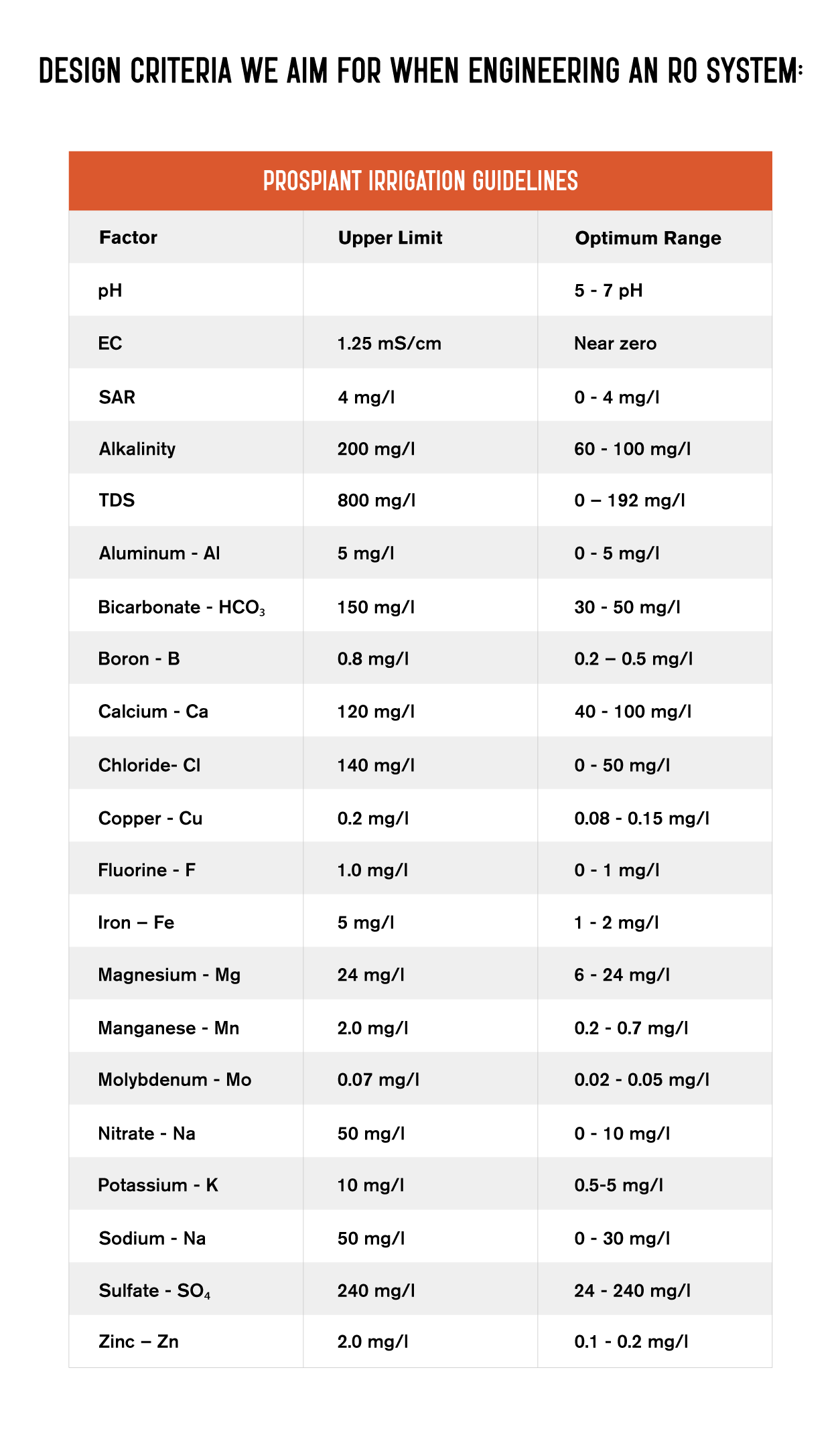
Water Storage
Treated water will then flow into a storage tank. There are two main types: aboveground and underground tanks. Aboveground tanks are more common as they cost less. However, they require some maintenance as they are exposed to the elements. Underground tanks not only require less frequent maintenance, they are space-efficient. But setting up an underground tank is a lot costlier, requiring earthwork and thorough pre-planning.
Whether you’re choosing an aboveground or underground tank, it is important to ensure it is adequately sized for your facility, as it can mean the difference between a successful growing season and millions of dollars’ worth of lost profits.
Here’s why:
- Water shortages can happen at any time. For example, your water supply could be shut down due to an oil spill. Days, or even weeks, may go by before water is restored and without a water storage tank, your crops’ growth may be hampered or even die. Particular attention must also be paid to facilities in areas prone to drought.
- Your RO water treatment system takes time to replenish. Without a water storage tank, your RO system may be pushed past its limits after just 10 minutes of watering your facility, causing inconsistent moisture levels across your crops. A water storage tank enables a more consistent flow rate, so all your crops get exactly the amount of water they need, at the exact time you want them to.
- The capacity of your city or well water line. Without an adequate supply line, your watering demands may not be met during peak times. Insufficient supply will make you water your plants based on the restricted flow rate, which could lead to less watering doses.
- Water storage tanks also allow for additional treatment such as dissolved oxygen enhancement and recirculation loops.
Investing in a water storage tank doesn’t just serve as insurance in case of a drought—it is crucial in ensuring consistent water output on any given day, and as a result, produces more consistent crops.
Pro tip: We typically recommend a 5,000 to 7,000-gallon water storage tank for a 25,000sqft facility but this may vary according to watering frequency and environmental factors.
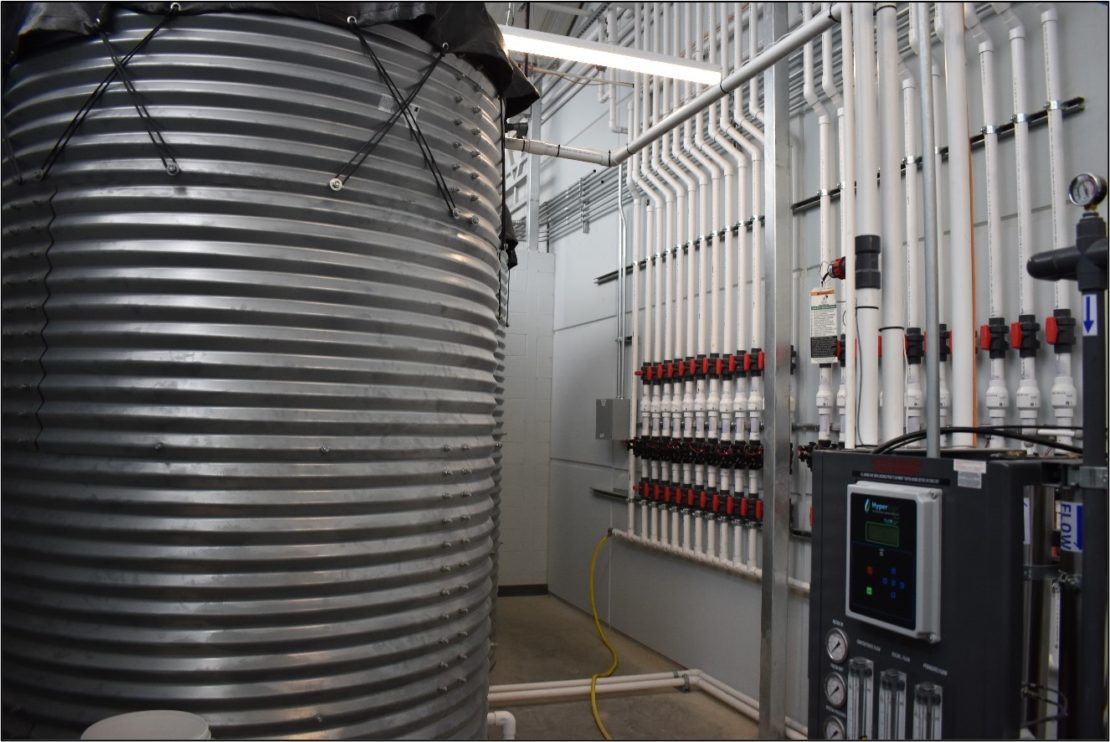
Fertigation
After your water has been treated through RO and stored, nutrients such as nitrogen and phosphorus are added via a nutrient injector to ensure your cannabis plant has everything it needs to achieve its maximum potential.
There are two types of nutrient injectors: automatic and manual. When considering a nutrient injector, it’s important for growers to pick one that affords them the greatest freedom and ease to calibrate their desired nutrient ratios.
Automatic nutrient injectors are a great option, especially for growers who are always experimenting with their own blend of nutrient mix. An automatic nutrient injector has multiple ports, which allows for a variety of nutrients to be quickly added to the water line. The ratio of each nutrient can also be swiftly determined with just the click of a button. An automatic nutrient injector also ensures more accurate nutrient dosing.
Another way to ensure a more accurate and uniformed nutrient dosing is by using a Batch Style nutrient injector. Compared to the Direct Inject method—which infuses the water with nutrients as it comes out of the injector—Batch Style ensures your water and nutrients are pre-mixed in a holding tank before being delivered to your plants. This fertigation dosing system allows for a more homogenous solution, and therefore, a more consistent distribution of nutrients and pH levels.
Have a zone just for mother plants and another for flowering plants? As each zone comes with different nutrient requirements, your automatic nutrient injector can also be programmed to deliver the right nutrients to the various plant zones with ease. And if you want to incorporate a nutrient at a specific time without having to wait around, you can schedule in advance.
Manual nutrient injectors, on the other hand, are typically less accurate and more labor-intensive, albeit less expensive. Manual nutrient injectors have their ratio manually set and can be put in series to inject several different nutrients into a single feed. They are typically wall-mounted and can take up a lot of space when multiple injectors are used for a single feed line.
For those opting for manual nutrient injectors, consider installing a fertigation stock tank, typically around 200 gallons, to dilute your nutrients and dose them into your water supply more accurately.
Pro tip: For better control over your cannabis plant’s outcome, talk to a controlled environment agriculture expert about integrating an automatic nutrient injector into your growing equipment system.
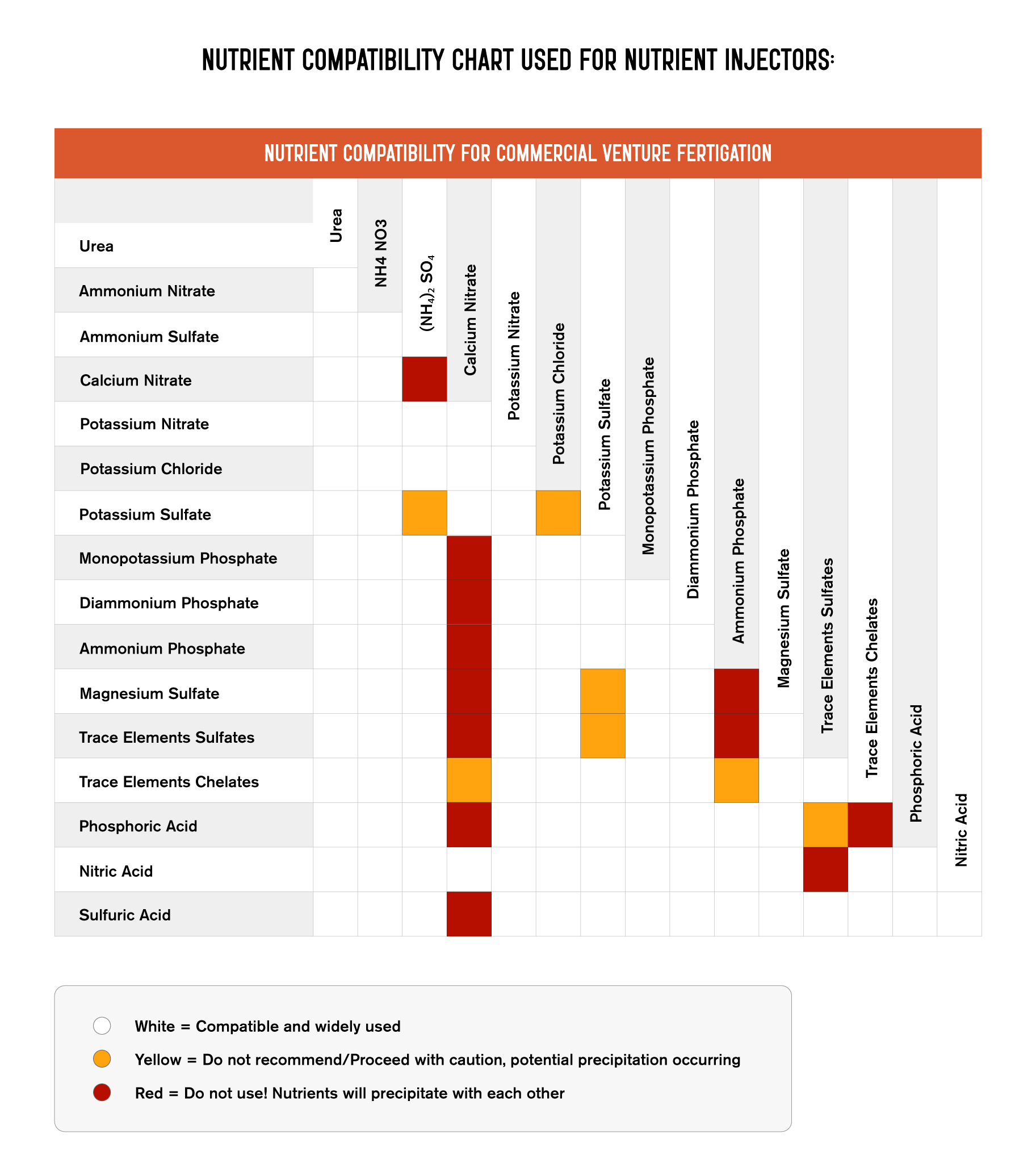
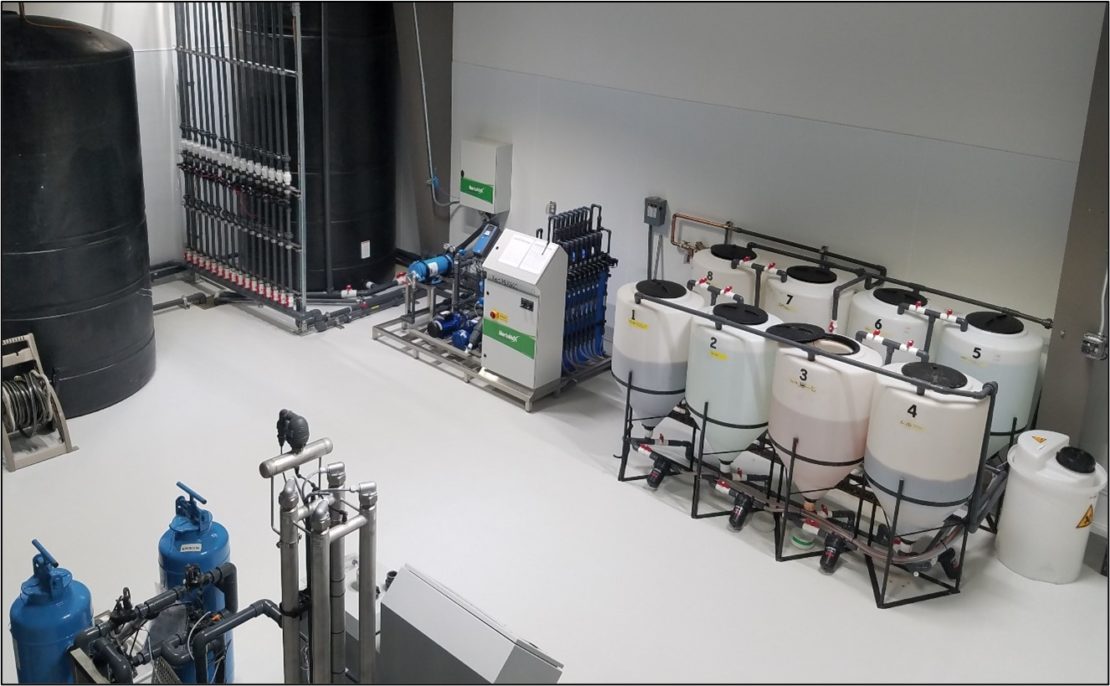
Irrigation
Now that a nutrient solution has been added to the treated water, it’s time to deliver the mixture to your crop. Ebb and flow irrigation and drip irrigation are two common irrigation systems.
Ebb and flow irrigation involves flooding the plant media with water and nutrient solution. Any excess will then flow out via drainage holes. While this watering method is cheaper and easier to set up, it can increase your facility’s humidity levels, which can affect the growth of your crops and must then be rectified with a dehumidifier.
In ebb and flow, poor, obstructed drainage systems also put your crops at risk of developing root rot. A root rot cuts off the oxygen supply to your crops’ roots, causing them to die.
Drip irrigation, on the other hand, sees water delivered to your plant media at very low rates via a drip emitter. Not only can it reduce the chances of root rot and microbial contamination and allow for more optimum growing conditions, but it also significantly lowers water consumption. Drip irrigation is the most water-efficient irrigation system, as 90% of the water delivered is absorbed by your plant[3].
Drip irrigation is by far more popular than ebb and flow, with as many as 95%-99% of projects using drip irrigation.
The amount of water and nutrient solution delivered, how often, and at what time of the day can all be programmed and scheduled ahead of time, bringing a great deal of convenience to growers.
Pro tip: It’s important to choose the right drip emitter size, as they vary depending on how fast and how much water you’d like delivered. They also determine the flow rate for the zone which has huge implications on your pump set if not sized correctly.
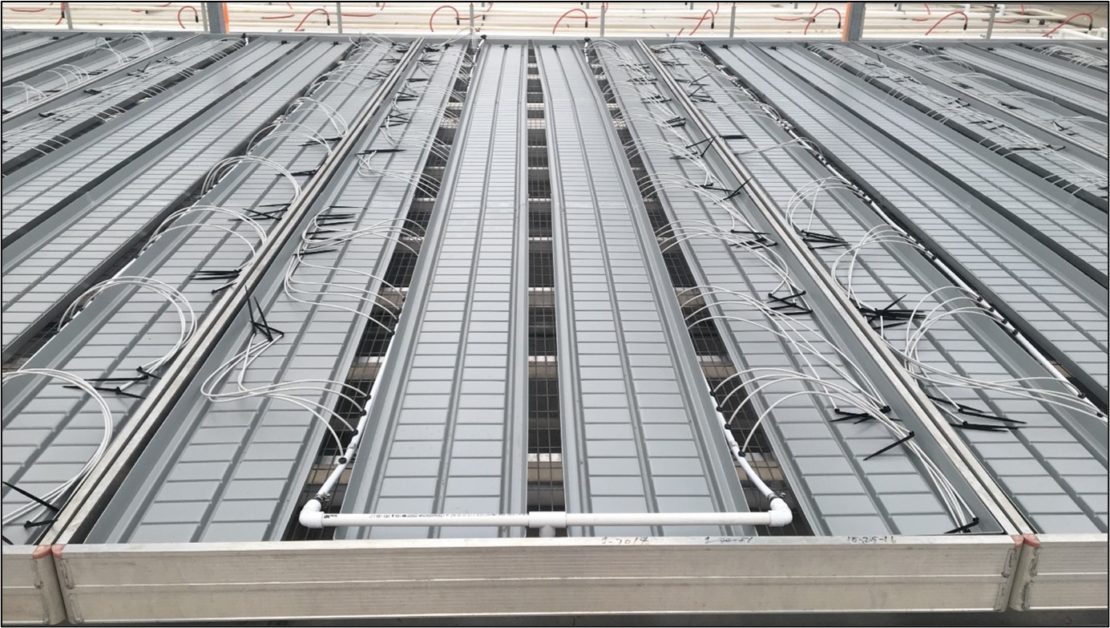
Recirculation Technologies
Excess water that drains from your plant after watering, or leachates, can then be reused by treating it first. There are three main reasons why cannabis growers opt to recirculate:
- It is required by law in your county, especially for growers in drier counties receiving limited rainfall. While many counties don’t mandate recirculation, they require that leachates be at least treated first before it is poured into the drain, as they may contain harmful compounds that cannot be treated by the municipal water system. Some growers then go the extra mile and treat the water well enough to be recirculated.
- It is more cost-efficient, as growers end up buying less water.
- It reduces the impact on the environment by limiting water consumption.
Leachates can be treated via ozone, UV, or RO water treatment systems. Choosing the right one depends on which compounds are present in the leachates. For example, UV may be effective in killing off pathogens like bacteria and viruses, but it is not able to remove dissolved impurities like pesticides, fluorides, and rust.
As pressure is mounting on governments and businesses to be more sustainable, having a recirculation system in place helps your business get ahead of the game before it becomes a requirement. But as setting up an effective recirculation system is complex and takes very precise engineering and design, it’s important to partner only with agtech solutions providers like Prospiant that have both the know-how and experience to deliver.
Pro tip: Keep tabs on your county’s wastewater management regulations to avoid legal action.
[1] “The best water for marijuana: Find out how to get it”, SEMILLAS-DE-MARIHUANA.COM, Aug 11, 2022, https://www.semillas-de-marihuana.com/blog/en/the-best-water-for-marijuana-find-out-how-to-get-it/
[2] “Reverse Osmosis and Removal of Minerals from Drinking Water”, The International Water Association, Aug 12, 2022, https://www.iwapublishing.com/news/reverse-osmosis-and-removal-minerals-drinking-water
[3] “Drip Irrigation”, The University of Rhode Island, Aug 30, 2022, https://web.uri.edu/safewater/protecting-water-quality-at-home/sustainable-landscaping/drip-irrigation